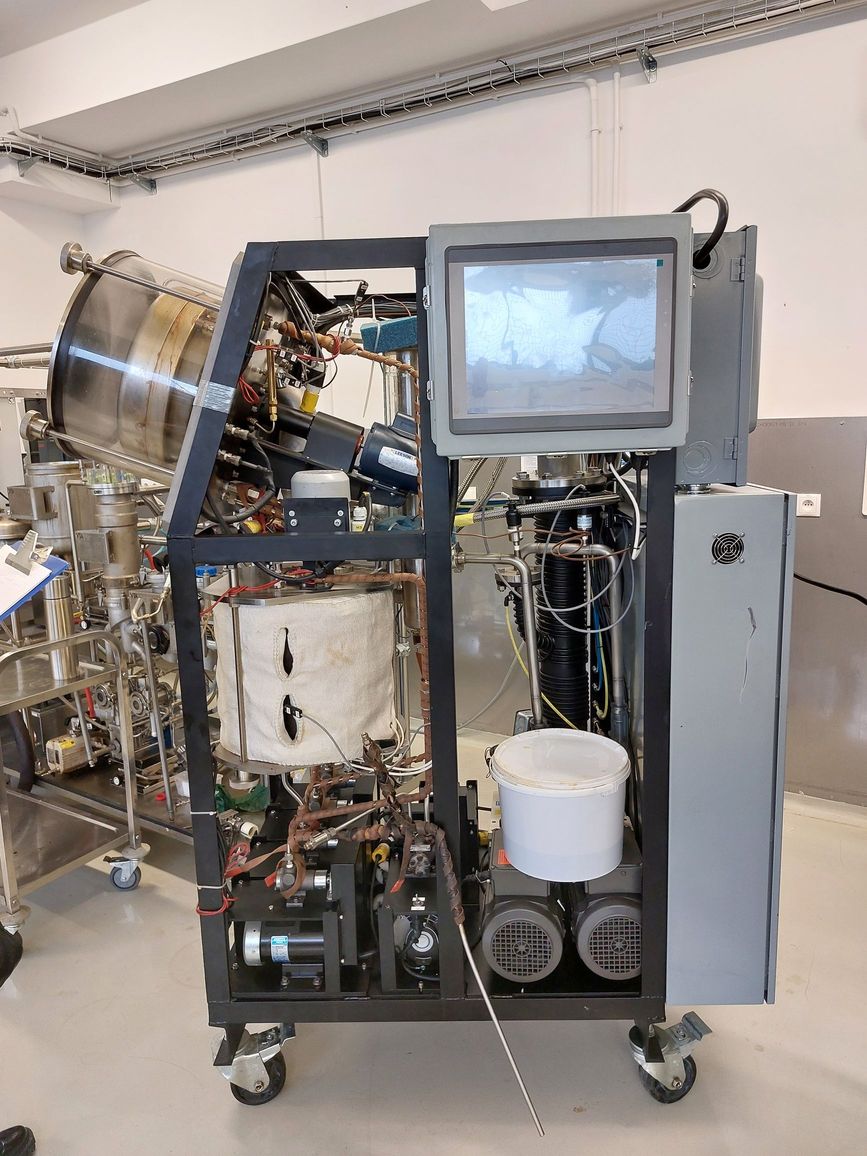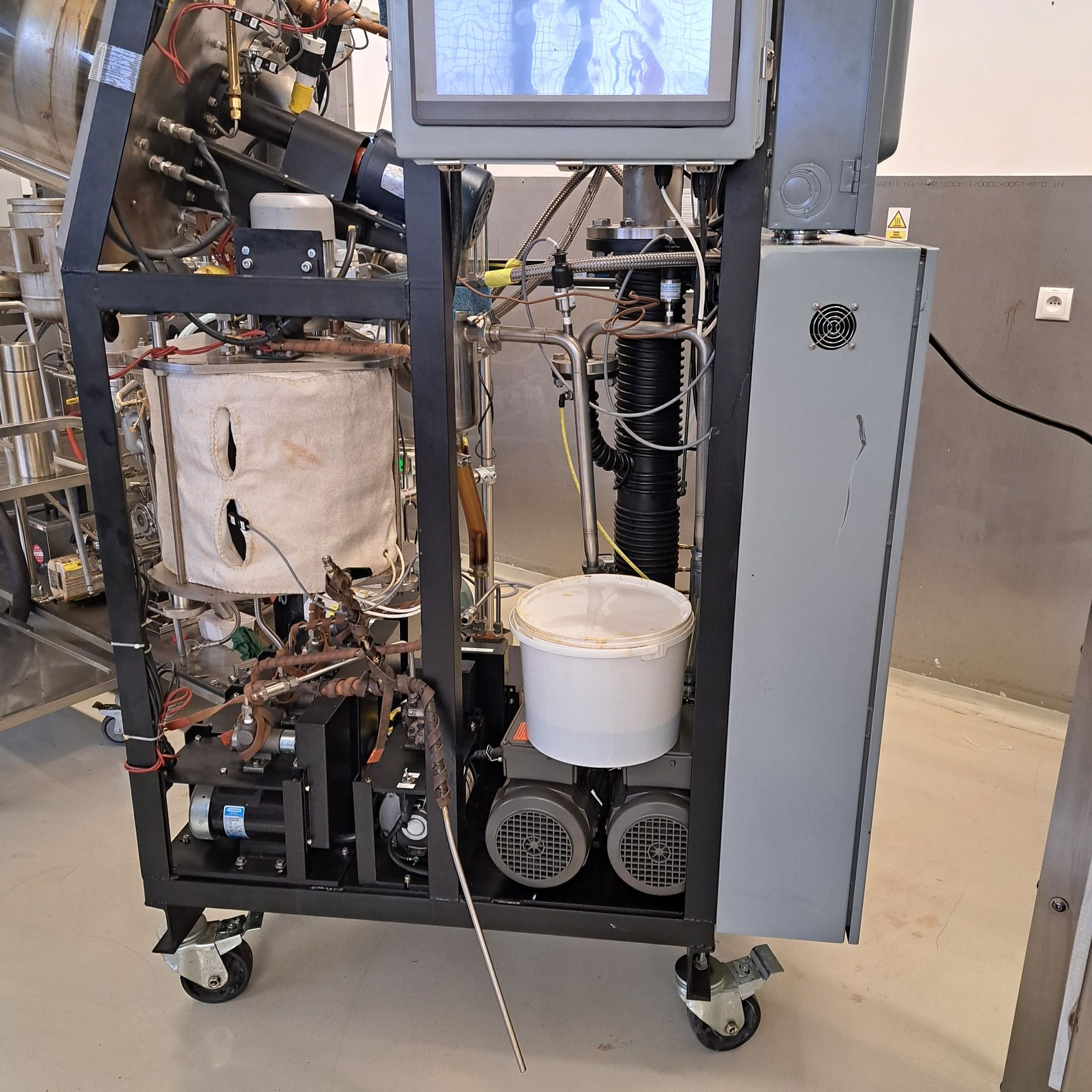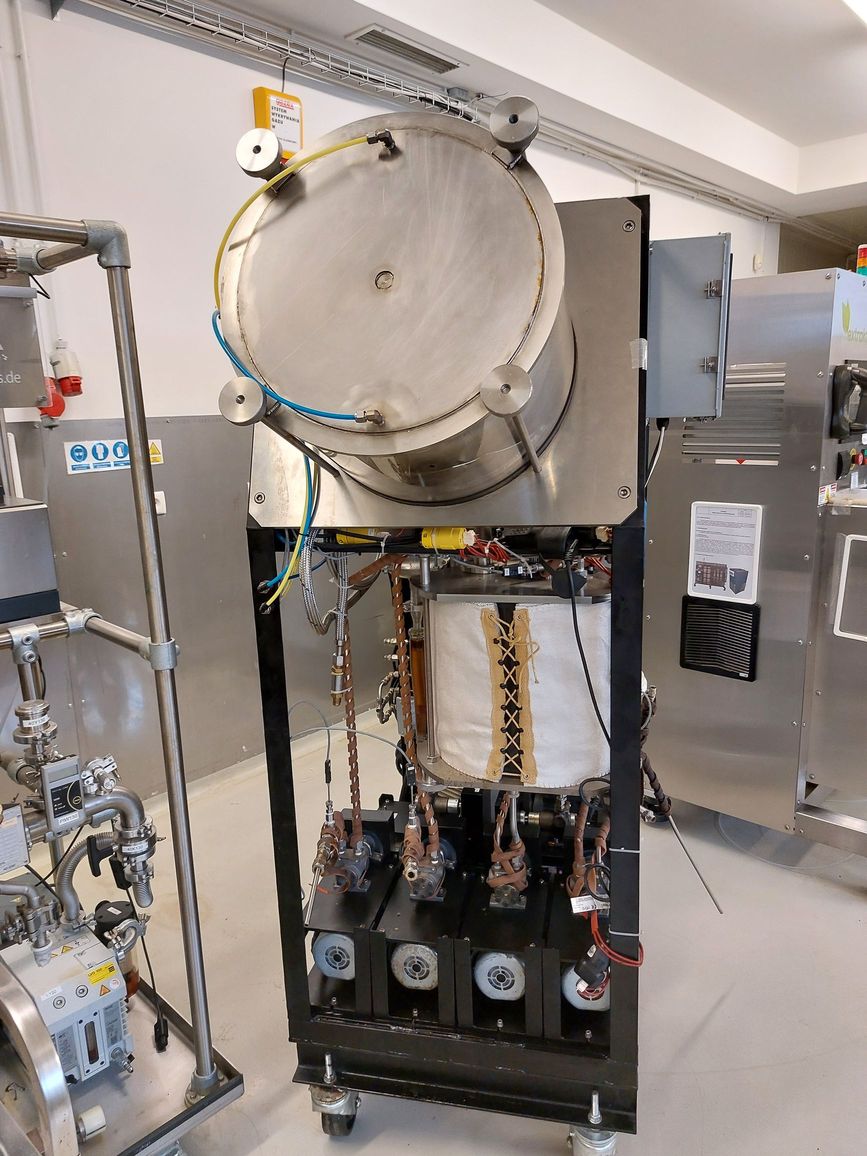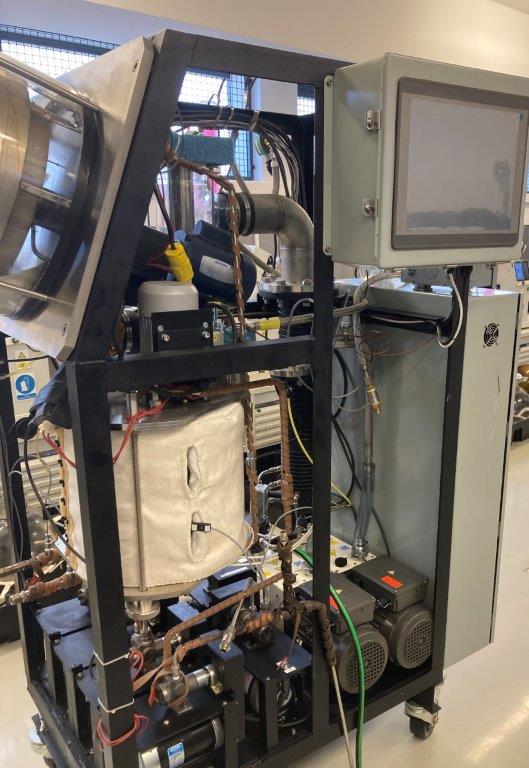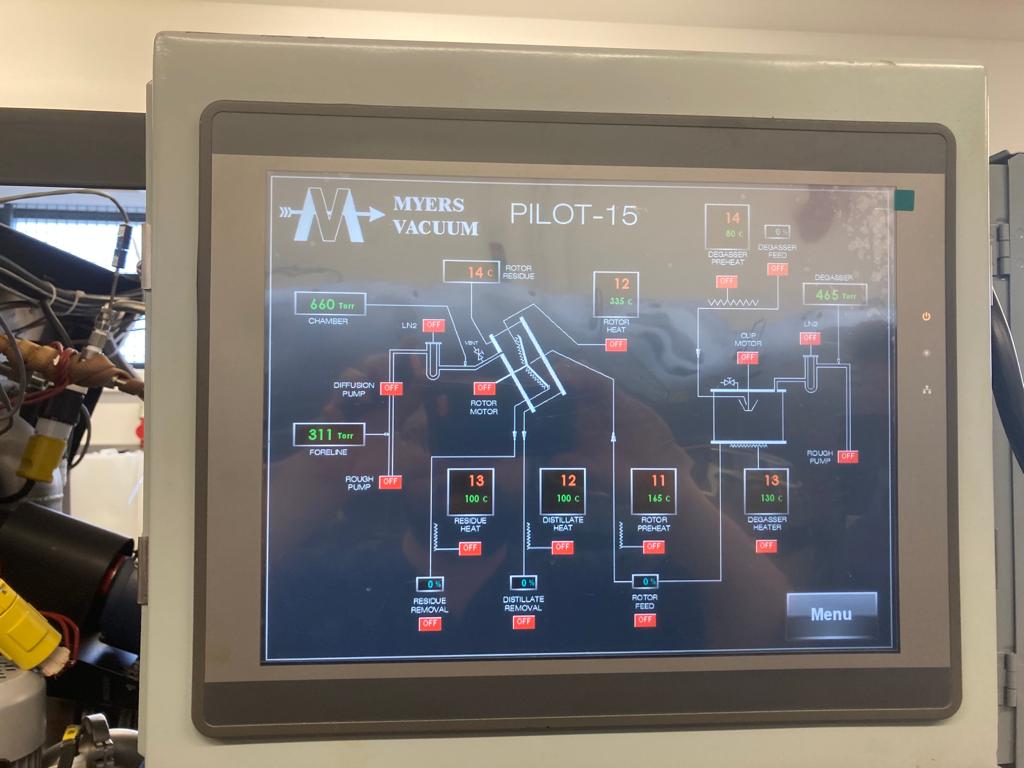
USED CENTRIFUGAL MOLECULAR DISTILLATION SYSTEM Manufacturer: MYERS VACUUM, Inc. Model: PILOT 15 LAB
Throughput Capacity 10 – 80 lbs/hr (4.5 – 36.3 kg/hr) Type Continuous
Pumping system ultimate pressure: 2 X 10-4 Torr Operating Pressure 10 -3 Torr to Atmosphere Mechanical Forepump >11 CFM
High Vacuum Pump 320 L/sec of air at 250C.
Power: 10-15 KW/ hour 3 phase “wye” 115/208 V, 5 wire 50/60 HZ Available for 230, 415 or 460 Volt.
Water: (20°C) 2 gal/min (7.6 L/min)
Liquid nitrogen consumption: 0.5 liters/ hour
(Utility consumptions may vary depending on process conditions)
Dimensions: Height 69 Inches (1.75m), Width 34 Inches (.86m), Depth 59 Inches (1.5m) Net Weight 1300 lbs. (590kg)
Centrifugal molecular distillation is a purification technique, which has gained wide acceptance in the chemical, food processing, pharmaceutical, and petroleum industries as well as the specialty chemicals industry. The PILOT-15 utilizes this technique for pilot plant and medium production needs on a continuous basis.
The PILOT-15 is a complete distillation system including all of the pumping, heating, vacuum generating and control equipment needed for operation. The small amount of floor space occupied by the unit helps make the PILOT-15, in single or multiple installations, a most attractive system. The control center features an easy to follow system schematic. The PILOT-15 is designed for throughputs between 10 and 80 lb/hr (4.5 to 36 kg/hr.), depending on feed material characteristics.
The major advantages to be expected from the PILOT-15 molecular still are:
- High product percentage yield
- Elimination of color bodies
- Elimination of odor fractions
- Reduction of acid values in ester distillation
- Removal of excess reactants
- Elimination of residual metal catalysts
- Minimized thermal hazard (a necessity for heat sensitive compounds)
The PILOT-15 is designed to continuously distill thermally sensitive organic and silicone compounds in the molecular weight range of 150 to 400 AMU at vacuum pressures from 1 to 700 X 10-3 Torr. Some examples of distillation from the PILOT-15 include fatty acid amides, dimer acids, epoxy resins, drying oils, monoesters, di-octyl phthalate, Vitamin A, and tocopherols (Vitamin E).
OPERATING OBJECTIVES
The PILOT-15 is designed to continuously distill thermally sensitive organic and silicone compounds in the molecular weight range of 150 AMU and higher at vacuum pressures from 1 X 10-3 Torr to Atmosphere. Some examples of distillation from the PILOT-15 are as follows:
- Fatty acid amides.
- Dimer acids.
- Epoxy resins.
- Drying oils.
- Monoesters.
- Di-octyl phthalate.
- Vitamin A.
- Tocopherols (Vitamin E).
MATERIAL HANDLING
The PILOT-15 is designed as a continuous flow, vacuum distillation system. The diagram illustrates the flow of material through the still.
- The material is pumped from the customer supplied supply/feed tank by a variable speed feed pump (12) into the degasser.
- In the degasser small amounts of low boiling materials and trapped gases are removed to enable more efficient vacuum distillation at the next stage.
- A variable speed feed pump (12) moves the degassed material onto the center of a heated, spinning Rotor (11) in the high vacuum distillation chamber (10).
- On the Rotor the material spreads out into a thin film. As the material spreads across the Rotor, a certain portion (the distillate) evaporates. The fraction which distills is selected by the operator by adjusting the temperature. Once set, this remains constant until the production run is completed or until new conditions are selected.
- The distillate vapor condenses in the vacuum chamber on a water cooled condenser in Chamber (10) and flows to a variable speed liquid transfer pump and is removed from the system through a check valve to atmosphere.
- The portion which does not distill, (the residue) flows off the edge of the rotor and is contained by a separate gutter and moves to a variable speed liquid transfer pump through a check valve to atmosphere.
- Depending upon the feed stock material or process requirements, either thedistillate or the residue may be your final product. In many cases both may be of value.
The PILOT-15 is designed to distill materials in the pressure range from atmosphere down to 1 X 10-3 Torr. The lower the distillation pressure, the lower the heat required to effect distillation. The lower the heat reduces the chance of destroying the product and reduces the energy costs of the purification process. The PILOT-15 has a complete vacuum system as can be seen from the diagram. Both the degasser and the high vacuum distillation chamber (10) are backed by vapor traps (4) and (5). These vapor traps will be cooled by LN2 or other suitable coolant. The degasser is pumped to operating pressures by a direct drive rotary pump (3). The distillation chamber is pumped by a diffusion-ejector pump system (2). This is backed by a second direct drive rotary pump (1). There are three station pressure monitors. This enables the operator to get accurate pressure measurements in the three critical areas: the degasser, the highvacuum chamber and the fore line.
CONTROL CENTER
All of the readouts and controls are conveniently grouped on a touch screen panel. On screen schematic shows the location of all components of the system. The screen offers display of the vacuum pressures and rotor residue. Plus the actual and set point temperatures of the degasser feed line heater, degasser jacket heater, rotor feed line heater, the rotor heater, residue line heater and distillate line heater. Controls of all vacuum pumps, feed pumps and motors are also located here.
The PILOT-15 Control Center controls and displays the following:
- Actual and set point temperature of the degasser feed line heater.
- Actual and set point temperature of the degasser heater jacket.
- Actual and set point temperature of the rotor feed line heater.
- Actual and set point temperature of the rotor heater.
- Actual and set point temperature of the residue and distillate removal lines
- Rotor residue temperature.
- Liquid transfer pump speed.
- Vacuum pressure of the degasser.
- Vacuum pressure of the distillation zone.
- Vacuum Pressure of the fore line.
- Indication of status and control of the vacuum pumps, motors and heaters.
The operator controls the process by setting the feedstock rate (How thick the material will be on the rotor) and the heater temperatures.
EQUIPMENT IN DETAIL
The PILOT-15 will accept process material from the customer-supplied storage tank. This material passes through stainless steel pipes through the variable speed feed pump. This pump controls the flow rate of material through the PILOT-15. From the feed pump the material passes along a length of heated pipe before entering the degasser.
Preheated material enters a rotating cup within the degasser and is spun onto the heated walls to quickly out gas the material. The media runs down and is collected on the heated base. A heating mantle surrounds the degasser walls. Degassed material passes, via a pipeline, to the distillation chamber feed pump.
From the feed pump the material passes along a length of pipe, which is heated to reduce any heat loss, entering the distillation chamber. This temperature is adjustable by the customer. In the distillation chamber the material is introduced onto the center of the spinning rotor disk and is spread across the heated surface. The surface area increases exponentially as material travels across the rotor thus exposing more material to the surface for evaporation as it travels across. Some material will separate into a vapor phase, the distillate, depending on the operators’ combination choice of temperature and pressure. The remaining material is the residue.
The distillate vapor is condensed on a water-cooled surface and flows down the chamber walls and out to the distillate pump. The residue passing across the full surface of the rotor is collected in a surrounding gutter and flows out of the chamber to the residue pump. On the exit of each pump is a non-return valve to isolate the distillation chamber from atmospheric pressure.
Feed, distillate, and residue storage tanks are to be supplied by the customer, unless specified otherwise. Both the degasser and distillation chambers have independent vacuum pumping systems which are protected with individual traps.
The traps in each vacuum line are refrigerated to protect from cross-contamination with the vacuum pump fluids. Both traps have drain taps, which are used to empty the traps while the PILOT-15 is shut down and at atmosphere. Trap collection vessels or gear pumps can be added to drain the traps while the PILOT-15 is running and are supplied by the customer or as an option. The degasser vacuum pump is a direct drive rotary vane positive displacement pump with exhaust to atmosphere. The distillation chamber vacuum pumps are a diffusion-ejector pump backed by a direct drive rotary vane positive-displacement pump with exhaust to atmosphere. System pressures are monitored at the degasser, distillation chamber, and the ejector pump’s fore line.
USER PROVIDED EQUIPMENT
The PILOT-15’s are very complete units, hence the only external requirements, in addition to power and water are:
- Suitable heated/cooled storage tank for the feed material.
- Suitable tanks to collect Distillate and Residue.
- Suitable cooling media for traps.


